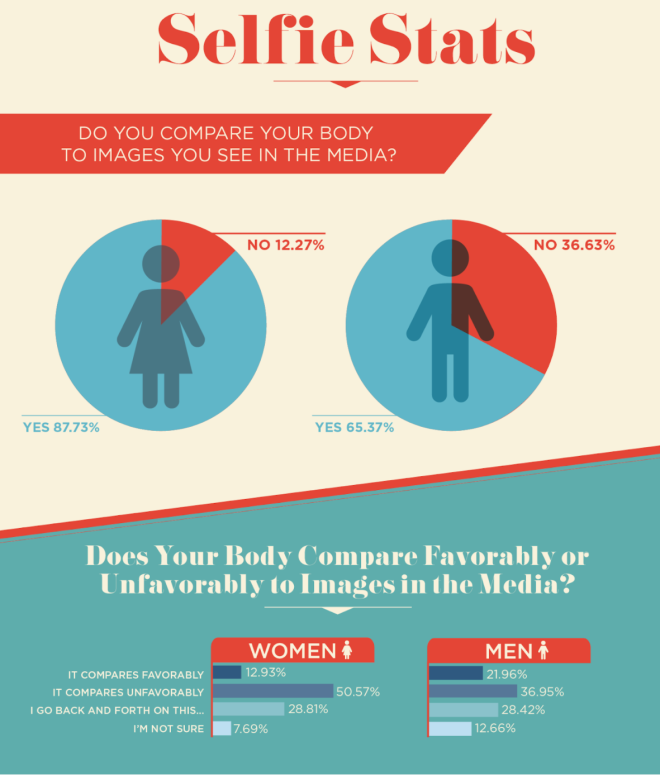Media have long contributed to the never-ending pressure to achieve unattainable and unrealistic beauty expectations. However, with the rising popularity of social media, photoshopped images of the “ideal” body are made readily available through the internet, shaping society’s concept of beauty. Social media influences how individuals perceive their own physical appearance and is associated with negative body image and an increase in disordered eating.
Research suggests that social media negatively affect body image and self-confidence. A healthcare institution known as the Florida House Experience conducted a study among 1,000 men and women in 2011, which suggests that 87% of women and 65% of men compare their bodies to images they see on social media. Of the 1,000 subjects, 50% of women and 37% of men view their bodies unfavorably when compared to the bodies they see on such websites.
The availability of photo editing apps creates a disconnect between perception and reality, pushing unattainable beauty standards onto users of social media. Social media platforms allow users to alter their appearance through apps and filters, creating toxic and unrealistic beauty expectations. The prevalence of eating disorders reflects the ingrained desire to achieve an impossible standard. According to the National Eating Disorder Association (NEDA), over 20 million American women and 10 million American men have suffered an eating disorder at some point in their lives. In fact, a study by Common Sense Media in 2015 revealed that about 80% of 10-year-old girls have been on a diet. Over half of girls and a third of boys between ages 6 to 8 years old engage in eating disorder behaviors and desire a thinner body. Social media may be a major contributor to increased negative body perception among younger populations. Children are often exposed to the objectification of celebrities’ bodies in media and a highly edited “idealized” body type from a young age, instilling an unattainable standard of beauty.
Project Know, a nonprofit organization for addictive behaviors, published a study suggesting that social media can worsen genetic and psychological predispositions to eating disorders in 2019. Although social media has not been proven to cause mental disorders, the study demonstrates that it can intensify pre-existing conditions. Many online accounts, groups, and hashtags associated with disordered eating are growing in popularity in the pro-ana (pro-anorexia) or pro-mia (pro-bulimia) movement. Those participating in this movement use social media and websites to encourage the development of eating disorders in teens and young adults. Adolescents suffering distorted body image and a lack of self-esteem are especially susceptible to such websites, as they offer a sense of community and validation over a shared goal of extreme weight loss. While these websites don’t directly cause body dysmorphia, they can trigger predispositions and worsen symptoms of an already existing disorder, by increasing an individual’s exposure to unhealthy body obsessions.
The growth of the “health and wellness” industry led to a rise of fitness creators, like Chloe Ting and Cassie “Blogilates” Ho, who encourage millions of followers to follow their “clean eating” and exercise regimens. While these health and fitness accounts can encourage some users to maintain a healthy lifestyle, a study by the University of South Florida in 2016 analyzed and compared the content of fitspiration and thinspiration websites. It discovered that both contained eerily similar language, targetted at inducing guilt for weight gain and promoting dietary restrictions. The Eating Disorder Hope organization expresses concern that such media promote disordered eating under the guise of a healthy lifestyle, leading to a condition known as “orthorexia” or an unhealthy fixation on “clean eating”.
Social media can potentially encourage body positivity, by creating an inclusive space for all body types, according to the Eating Disorder Hope. A trend of “body positivity” or “BoPo” emerged in 2015 with the goal of challenging traditional beauty ideals and encouraging acceptance of bodies regardless of appearance. American plus-size model Tess Holliday is often credited for kickstarting the movement with hashtags like #bodypositive and #effyourbeautystandards. The campaign encourages individuals to display their bodily “imperfections”, like cellulite and stretch marks, and places an emphasis on focusing on their body’s functionality rather than its appearance. Sarah Gervais, Ph.D. of Psychology Today claims that social media allows “the public to reclaim photography as a source of empowerment in a way that has never been possible before”, by allowing the public to be a diverse range of people. Such research suggests that social media users can improve their own body image by simply shifting the focus of their feeds and followers, which can include anything from unfollowing accounts that are marketing products with their bodies to keeping up with accounts that promote a realistic take on healthy living.
